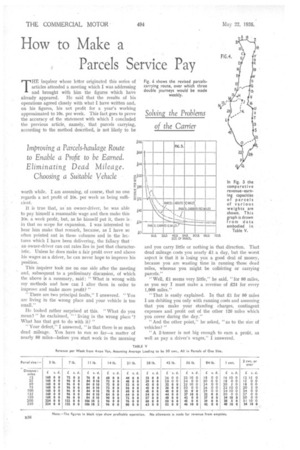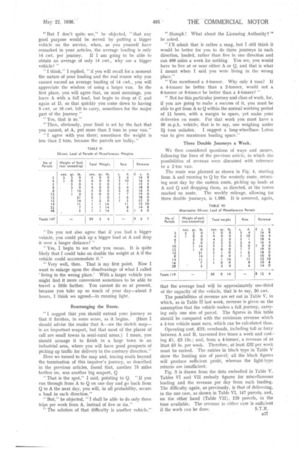How to Make a Parcels Service Pay
Page 46

Page 47

If you've noticed an error in this article please click here to report it so we can fix it.
THE inquirer whose letter originated this series of articles attended a meeting which I was addressing and brought with him the figures which have
already appeared. He said that the results of his operations agreed closely with what I have written and, on his figures, his net profit for a year's working approximated to 10s. per week. This fact goes to prove the accuracy of the statement with which I concluded the previous article, namely, that parcels carrying, according to the method described, is not likely to be
worth while. I am assuming, of course, that no one' regards a net profit of 10s. per week as being sufficient.
It is true that, as an owner-driver, he was able to pay himself a reasonable wage and then make this 10s, a week profit, but, as he himself put it, there is in that no scope for expansion. I was interested to hear him make that remark, because, as I have so often pointed out in these columns and in the lectures which I have been delivering, the fallacy that an owner-driver can cut rates lies in just that characteristic. Unless he does make a fair profit over and above his wages as a driver, he can never hope to improve his position.
This inquirer took me on one side after the meeting and, subsequent to a preliminary discussion, of which the above is a summary, said: " What is wrong with my methods and how can I alter them in order to improve and make more profit?" 'There are two principal faults," I answered. "You are living in the wrong place and your vehicle is too small."
He looked rather surprised at this. "What do you mean? " he exclaimed, " living in the wrong place '? What has that got to do with it? "
"Your defect," I answered, "is that there is so much dead mileage. You have to run so far—a matter of nearly 80 miles—before you start work in the morning and you carry little or nothing in that direction. That dead mileage costs you nearly 21 a day, but the worst aspect is that it is losing you a good deal of money, because you are wasting time in running -those dead miles, whereas you might be colldcting or carrying parcels."
"Well, 21 seems very little," he said, "for 80 miles, as you say I must make a revenue of 224 for every 1,000 miles."
"That is easily explained. In that 21 for 80 miles I am debiting you only with running costs and assuming that you make your standing charges, contingent expenses and profit out of the other 120 miles which you cover during the day."
"And the other point," he asked, "as to the size of vehicles? "
"A 2-tonner is not big enough to earn a profit, as well as pay a driver's wages," I answered.
"But I don't quite see," he objected, 'that any good purpose would be served by putting a bigger vehicle on the service, when, as you yourself have remarked in your .articles, the average loading is only
14 cwt. per journey. If I am going to be able to obtain an average of only 14 cwt., why use a bigger vehicle? "
" I think," I replied, "if you will recall for a moment the nature of your loading and the real reason why you cannot exceed an average loading of 14 cwt., you will appreciate the wisdom of using a larger van. In the first place, you will agree that, on most mornings, you leave A with a full load, but begin to drop at C and again at D, so that quickly you come down to having 5 cwt. or 10 cwt. left to carry, sometimes for the major part of the journey."
" Yes, that is so."
"Then, obviously, your limit is set by the fact that you cannot, at A, put more than 2 tons in your van."
"I agree with you there; sometimes the weight is less than 2 tons, because the parcels are bulky."
"Do you not also agree that if you had a bigger vehicle, you could pick up a bigger load at A and drop it over a longer distance?"
"Yes. I begin to see what you mean. It is quite likely that I could take on double the weight at A if the vehicle could accommodate it."
"Very well, then. That is my first point. Now I want to enlarge upon the disadvantage of what I called 'living in the wrong place.' With a larger vehicle you might find it more convenient sometimes to be able to travel a little farther. You cannot do so at present, because you take up so much of your day—about 3 hours, I think we agreed—in running light.
Rearranging the Route.
'I suggest that you should extend your journey so
that it finishes, in some sense, as it begins. (Here I should advise the reader that A—see the sketch map— is an important seaport, but that most of the places of call are small towns in semi-rural areas.) I mean, you should arrange it to finish in a large town in an industrial area, where you will have good prospects of picking up traffic for delivery in the contrary direction."
Here we turned to the map and, tracing south beyond the termination of this inquirer's journey, as described in the previous articles, found that, another 75 miles farther on, was another big seaport, Q "That is the spot," I said, pointing to Q. "If you run through from A to Q on one day and go back from Q to A the next day, you will, in all probability, secure a load in each direction."
"But," he objected, "I shall be able to do only three trips per week from A, instead of five or six."
"The solution of that difficulty is another vehicle."
" Humph r What about the Licensing Authority?" he asked.
"I'll admit that is rather a snag, but I still think it would be better for you to do three journeys in each direction, loaded, rather than five in one direction and run 400 miles a week for nothing. You see, you would have to live at or near either A or Q, and that is what I meant when I said you were living in the wrong place."
"You mentioned a 4-tonner. Why only 4 tons? If a 4-tonner be better than a 2-tonner, would not a 6-ton ner or 8-tonn,:r be better than a 4-tonner? "
" Not for this particular journey and class of work, for, if you are going to make a success of it, you must be able to get from A to Q within the normal working period of 11 hours, with a margin to spare, yet make your deliveries en route. For that work you must have a 30 m.p.h. vehicle; that is to say, one weighing under 21 tons unladen. I suggest a long-wheelbase Luton van to give maximum loading space."
Three Double Journeys a Week.
We then considered questions of ways and means, following the lines of the previous article, in which. the possibilities of revenue were discussed with reference to a 2-ton van.
The route was planned as shown in Fig. 4, starting from A and running to Q by the westerly route, returning next day by the eastern route, picking up loads at A and Q and dropping them, as directed, at the towns marked en route. The weekly mileage, allowing for three double journeys, is 1,080. It is assumed, again, that the average load wig be approximately one-third of the capacity of the vehicle, that is to say, 30 cwt.
The possibilities of revenue are set out in Table V. in which, as in Table II last week, revenue is given on the assumption that the vehicle makes a full journey, carrying only one size of parcel. The figures in this table should be compared with the minimum revenue which a 4-ton vehicle must earn, which can be calculated thus.
Operating cost, £23; overheads, including toll or ferry between A and B, traversed five times a week and cost-. ing 21, 23 15s.; and, from a 4-tonner, a revenue of at Mast £5 Ss. per week. Therefore, at least £32 per week must be earned. The entries in black type in Table V show the limiting size of parcel; all the black figures will produce sufficient profit, whereas the light-type returns are insufficient.
Fig. 3 is drawn from the data embodied in Table V. Tables VI and VII embody figures for miscellaneous loading and the revenue per day from such loading. The difficulty again, as previously, is that of delivering, in the one case, as shown in Table VI, 147 parcels, and, on the other hand (Table VII). 119 parcels, in the time available. The revenue in either case is sufficient
if the work can be done. S.T.R.




















































































